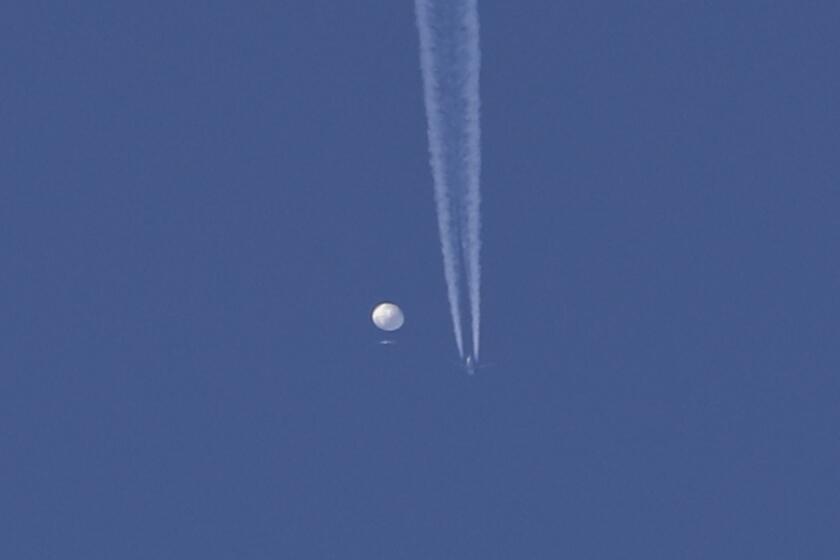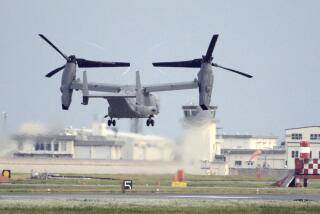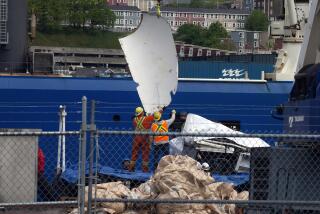Navy divers begin pulling up Chinese spy balloon debris

- Share via
WASHINGTON — Navy divers began pulling pieces of the downed Chinese spy balloon from the depths of the ocean floor on Tuesday, using sophisticated reconnaissance drones dubbed the Kingfish and the Swordfish to locate the debris.
After collecting all of the balloon’s white fabric and shell structure found floating on the surface, the Navy has now shifted to an all-underwater search for the remnants of the massive balloon that a U.S. fighter jet shot down off the coast of South Carolina on Saturday, officials said.
Navy and Coast Guard personnel were using underwater drones to locate and map the debris field, and divers were in the water gathering what they could, officials said.
The debris already collected was being hauled by small boats to a few area locations, including a Coast Guard station south of Myrtle Beach, and, depending on the size, will eventually go either to the FBI lab at Quantico, Va., or other sites where experts can analyze it, said the officials, who spoke on condition of anonymity to provide details of an ongoing military operation.
The head of U.S. Northern Command, Gen. Glen VanHerck, who is in charge of the recovery effort, and several Biden administration officials will brief members of Congress on the balloon on Wednesday and Thursday.
Lawmakers have raised a number of questions about whether the balloon was able to collect intelligence and transmit it back to China during the time it traveled eastward across the United States, after crossing the border from Canada into Idaho.
The U.S. on Saturday downed a suspected Chinese spy balloon off the Carolina coast after it traversed sensitive military sites across North America and became the latest flashpoint in tensions between Washington and Beijing.
White House and Pentagon officials have largely avoided providing any details on the balloon’s capabilities.
Officials said Tuesday the U.S. was very aware of the sites the balloon crossed over — including nuclear missile silos and other military installations — and knows how to protect them from any intelligence collection. Even if the balloon was able to transmit, they said, it wasn’t getting any new or important information to send.
The officials were unwilling to provide any insight into what the U.S. has been able to glean about the balloon’s collection and transmission abilities.
The balloon, an estimated 200 feet tall, was carrying a long sensor package underneath, which VanHerck estimated was the size of a small regional jet.
U.S. counterintelligence teams hope to learn far more about the sensors and other equipment on the balloon as they retrieve it and study it.
The balloon debris is scattered in waters that are about 50 feet deep but stretch across an area 15 football fields long and 15 football fields across, VanHerck said.
In new images released Tuesday, sailors from Explosive Ordnance Disposal Group 2 can be seen leaning over a rigid hull inflatable boat and pulling in broad swaths of the balloon’s white outer fabric and shell structure.
VanHerck has also said the recovery teams are taking precautions to safeguard against the chance any part of the balloon was rigged with explosives or was dangerous in any way.
A Navy warship, the USS Carter Hall, is heading the recovery effort, aided by three Coast Guard cutters — the Venturous, the Richard Snyder and the Nathan Bruckenthal — as well as the USNS Pathfinder, an oceanographic survey ship. A salvage ship is expected to arrive on Wednesday.
The Pentagon said Tuesday that Defense Secretary Lloyd J. Austin III requested a secure call with his Chinese counterpart, Minister of National Defense Wei Fenghe, on Saturday after the balloon was shot down. China declined the request, said Brig. Gen. Pat Ryder, the Pentagon press secretary.
“Lines between our militaries are particularly important in moments like this. ... Our commitment to open lines of communication will continue,” Ryder said.
More to Read
Sign up for Essential California
The most important California stories and recommendations in your inbox every morning.
You may occasionally receive promotional content from the Los Angeles Times.











